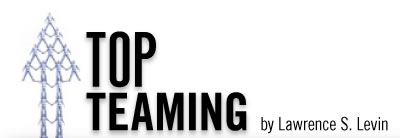BUILDING TOP TEAMS: WHEN VISION AND REALITY COLLIDE
Building Top Teams: When Vision and Reality Collide
There is an old saying that “Love is an ideal thing, marriage a real thing; a confusion of the ideal and the real never goes unpunished.” (Goethe) And so it is with the collision between vision and reality. Vision is an idealized state—something to which companies aspire. Vision is formed when the senior team goes on an offsite and envisions the desired future of the firm. It is, by definition and by its very nature, a state that organizations rarely reach. And, cynically, it is that poster in the lunchroom that most people see but don’t see.
About four years ago, I was at the corporate headquarters of a fast-growing pharmaceutical company having lunch with a group of managers. The food was terrific, the view of the lake and Japanese maples exquisite, and the vision statement on the wall-mounted plasma monitors inspiring as it scrolled over the waterfall backdrop. I commented as to what an inspiring vision it was. One of the managers briefly paused in mid-bite as he said tersely, “It’s a lie.”
I was struck by his candor and his bitterness and realized at that moment that no false promise, no matter how aspirational or inspirational, ever goes unpunished. The gap between what was written and what was real, between what was said and what was done, between talk and walk, was significant—and it greatly impacted the workforce. Turnover, just after bonus time, was significant. Major initiatives were delayed and postponed as they were constantly getting new people up to speed. Competitors entering the market quickly gobbled up talented ex-employees. And management team members seemed to have no clue. In their case, the “light at the end of the tunnel” (as represented by their vision) was indeed the headlight of an approaching train. They had a Vision but could not define what they were FOR in ways that key people understood and could support. And because of this, they could not craft a going-forward strategy that made sense and that people could align behind.
Ensuring that you have a vision that is not at odds with reality is essential to the intellectual and psychological makeup of a workforce. And it is the full and complete responsibility of the senior team who must utilize the vision as a “stretch” to connect current realities to a desired future. As my partner, Dr. Patricia Wheeler, reminds me, “It’s not what a vision is, it’s what it does.” A workforce is always watching the leaders’ feet to see if they are walking the talk. And this is even truer in times of increased turbulence and complexity.
As executive teams think about and work toward aligning their organizations, defining clear priorities, setting goals, and consciously instilling a culture that can perform, they have to ensure that:
- § They have a terrific grasp on current realities, which include external influences, political and global circumstances, changes in technologies, customer issues, and their own capabilities
- § They also have to be aware of their internal realities, which include history, culture, behaviors, and competencies.
Stay tuned.
